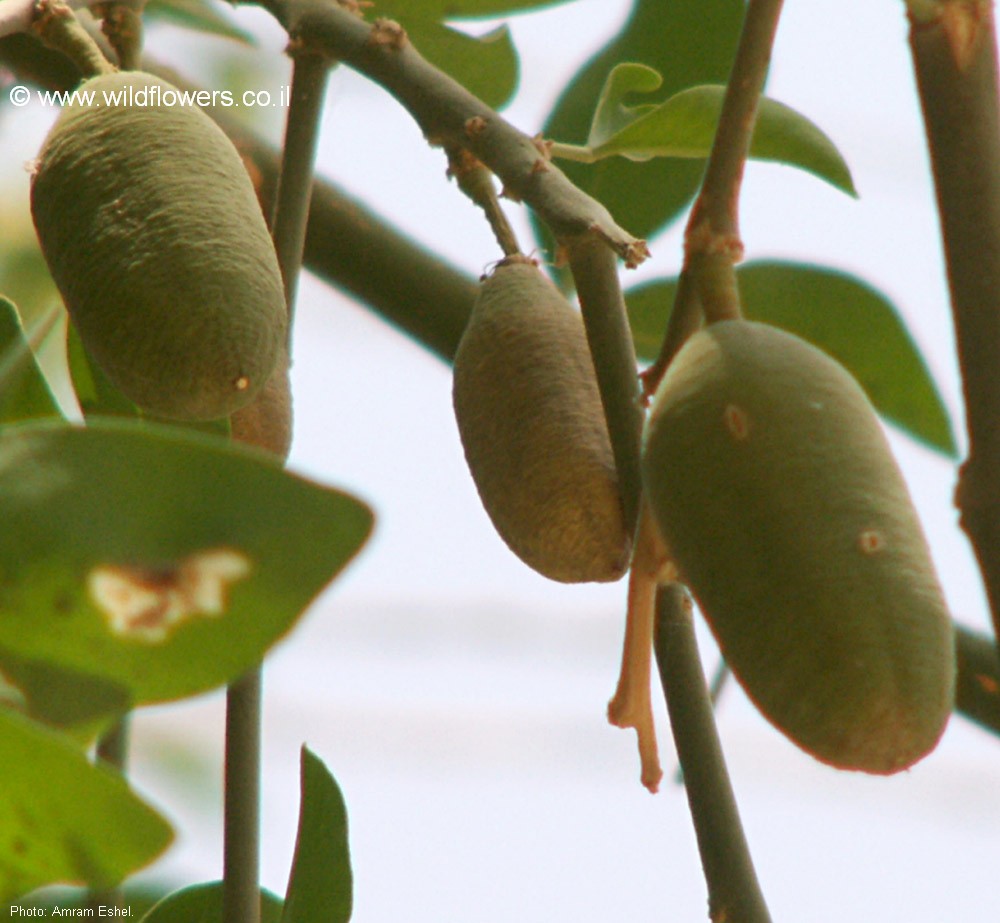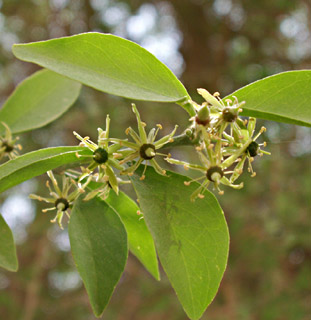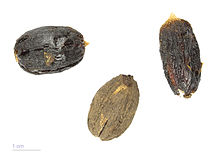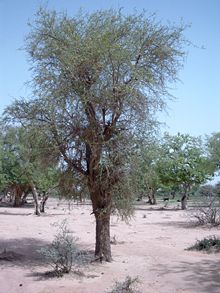Balanites aegyptiaca (L) Del.
| Botanical Name | Balanites aegyptiaca (L) Del. |
| Order: | Zygophyllales |
| Family: | Zypoghyllaceae |
| Genus: | Balanites |
| Species: | B. aegyptiaca |
| Common Names: | Soap berry tree, Thom tree (English); Desert date, Dattier du desert (French) |
Plant Synonyms
Ximenia aegyptiaca L., Agialida senegalensis van Tiegh, Agialida bateri van Tiegh., Balanites zizphoides mildbr & Schlechter
Plant Local Names
Burkina Faso: Moore-kyeguelgga, Diola- zekene, Fulfulde-tenne, Yoleteki
Ghana: Dagaare-gongo
Mali: Bambara-zekene; Dogon-mono, Noms-tale:
Senegal: Wolof – sump; Serer – model, lol; Arebe – hadjiidj
Togo: Goumantche – konnkonlangpag; Mba – okopakbo
Plant Habitat
The desert date palm occurs mainly in tropical Africa particularly in central and Western Sahara, and Far East. It originated from the medeterranean via Egypt and grows well in sandy soil and on all types of geographical landscape; depressions, valleys, plains, and even montains.
Plant Material of Interest
Fruit, Stem Bark
Plant Description
Thony tree, deciduous, up to 8 metres high, with large and complex branching well defined trunk, straight or slightly twisted, greyish- brown bark, fissured longitudinally; numerous branches, with straight spines 2-7 cm; young secondary branches are green, pubescent and also thomy; inforescence is indeterminate, comprises of 5 to 12 flowers arranged on a pubescent stem, of variable length; fruit is a fleshy drupe 1 to 2.5 cm long, oval oblong, silky – pubescent surface and greenish- white with a single seed inside blooms from March to May and fruits from July to October.
Plant Used Parts
Plant Uses
In the Sahel, the leaves and fruits are dried and processed into powder for use in preparing sauce (Cook et al., 1988; Lockett et al., 2000). Edible oil is extracted from the kemels (Kamael and Koshinen, 1995). The fruit extract is added to treat pain and discomfort associated with excessive intestinal motility and bloating (Lockett et al., 2000. B. aegyptiaca is one of the most palatable forage species for domestic grazing animals (Toutain, 1980; Savadogo, 2004). The root bark is crushed, added to water, soaked and drunk for its purgative effect (Koch et al., 2005). The seeds are used to treat cancer and hydrocele (Abubakar et al., 2007). The stem and root bark are powdered and mixed with other species, and then boiled with watwer for use against oral candidiasis (Rumyoro et al., 2006a). The stem bark is macerated in warm water and the resulting extract taken for asthma, dry cough and chest infection (Maregesi et al., 2007). Some medicinal preparation are made with essential oils extracted from part of B aegypptiaca (Said et al., 2002). The leaves of the plant and young branches are meceated and applied fresh as poultice on wounds (Sait et al., 2002). The powdered root of the plant is dissolved in water, and then used as a bath to treat measles. It is also taken as tea agaimst uterine fibroids (Tabuti et al., 2003). Or made into a paste and applied to bleeding gums or inserted into the cavity of painful tooth three times per day until recovery (Tapsoba and Deschamps, 2005).
Plant Therapeutic Action
Abtidiabetic (Kamel et al., 1991). Antihelmintic (Koko et al., 2005), anticancer (Gnoula et al., 2008), antipyretic, molluscicidal (Iwu, 1983), antibacterial (Tangiguchi et al., 1978 Liu and Nekanishi, 1982) antifungal (Saeed et al, 1985; Speroni et al., 2004); anti- inflammatory antimicrobial (Speroni et al., 2004; Runyoro et al., 2006b; Nanying et al., 2008) and immunmodulatory (Koko et al., 2008).
Plant Precaution for Use
The blood glucose of the patient should be monitored.
Plant Adverse Effect
May induce hypoglycaemia
Plant Contraindication
Hypoglycaemia
Plant Dosage Forms
Decoction; ointment; tincture
Decoction: 30-50 g per litre of water; take 3-5 teacup daily
Tincture: 1:5 in 50% alcohol; 5 ml three times a day.
Plant Dosage
Plant Storage
Store in a cool dry place
Plant Chromatographic Fingerprint
Analytical TLC on silica gel G60 F254, 0.25 mm layer in petroleum ether (40-60 ???? Cychloroform [28], detection in daylight, after spraying with anisaidehyde (0.5 ml) mixed with 10 ml glacial acetic acid, 85 ml methanol and 5 ml concentrated sulphuric acid and heated to 100- 110C????? for 5 – 10 min. presssence of three characteristics spots wiith R,s 0.45 (ash), 0.31 (pink) and o.027 (pink).
Plant Constituents
Protein carbonhydrate (Nour et al., 1986); saponins (balantines -3, 6-methyldiosgenin, balanitoside; (Kamel 1998; Hosny et al., 1992), pregnane glycosides (Kamel and Koskinen, 1995).
Plant Pictures
Plant References
Abubakar, M.S., Musa, A.M., Ahmeda, A., Hussaini, I.M. (2007). The perception and practice of traditional medicine in the treatment of cancers and inflammations by the Hausa and Fulani tribes of Northern Nigeria Journal of Ethnopharmacology 111:625-629.
Cook, J.A., Vanderjagt, D.J., Pastuszyn, A., Mounkalia, G et al., (1998). Nutrient content of two indigenous Plant foods of the werstem Sahel: Balanites aegypiaca and Maerua crassifolia. Journal Food Composition and Analysis 11:221-230.
Ghana Herbal Pharmacopoeia (2007). STEPRI Accra, Ghana.
Gnoula, C., Megalizzi, V., De Neve, N., Sauvage, S., Ribaucour, F., et al. (2008). Balnitin-6 and -7: diogenyi saponins isolated from balantites aegyptiaca Del. display significant anti-tumor activity in vitro and in vitro. International Journal of Oncology 32 (1):5-15.
Hosny, M., Khalifa, T., Calis, I., Wright, A.D., Sticher, O. (1992). Balanitoside, a furostanol glycoside, and 6-methyldosgenin from Balanites aegyptiaca. Phytochemistry, 31(10): 3565-3569.
Iwu, M.M., (1993). Handbook of Africa Medicinal Plants CPC Press, Boca Raton Florida, USA.
Kamel, M.S. (1998). A flurostanol saponin from fruits of Balantites aegyptiaca. Phytochemistry 148(4):755-757.
Kamel, M.S., Koskinen, A. (1995). Prognane glycosides from fruits of Balanites aegyptiaca. Phytochemistry 40(6):1773-1775.
Kamel M.S., Ohatani, K., Kurokawa, T., Assaf, M.H., el-Shanawany, M.A. et al., (1991). Studies on Balantites aegyptiaca fruits, an antidiabetic Egyptian folk medicine. Chemical and pharmaceutical Bulletin (Tokyo), 39(5):1229-33.



